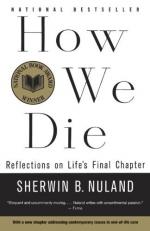
|
| Name: _________________________ | Period: ___________________ |
This test consists of 15 multiple choice questions and 5 short answer questions.
Multiple Choice Questions
1. What Latin term does the author use to describe the “art of dying” in the Introduction?
(a) Arsmoriendi.
(b) Sub divo.
(c) Facfortiaetpatere.
(d) Manibus date liliaplenis.
2. What does Dr. Nuland discuss that is also called also called coronary artery or coronary heart disease in Chapter 1?
(a) Hodgkinson’s disease.
(b) Alzheimer’s disease.
(c) Corollary heart disease.
(d) Ischemic heart disease.
3. Dr. Nuland compares the metabolic changes of aging to what in Chapter 3?
(a) The parts-replacement capability in a machine.
(b) A decaying piece of fruit.
(c) A computer becoming obsolete.
(d) A truck rusting in the field.
4. What is the title of Chapter 5?
(a) "Accidents, Suicide, and Euthanasia."
(b) “A Valentine—and How it Fails.”
(c) "The Malevolence of Cancer."
(d) “Alzheimer’s Disease.”
5. The lower chambers of the human heart are referred to by what name?
(a) Embolus.
(b) Plasmid.
(c) Atria.
(d) Ventricles.
6. When did the first correctly diagnosed myocardial infarction occur?
(a) 1893.
(b) 1935.
(c) 1878.
(d) 1912.
7. Dr. Nuland theorizes that 85% of the aging population will die from one of seven primary causes, which he refers to as what in Chapter 4?
(a) The seven doors to the afterlife.
(b) The seven knives of doom.
(c) The Grim Reaper’s seven sons.
(d) The seven horsemen of death.
8. What refers to neurotransmitters that are produced by the pituitary gland and the hypothalamus in vertebrates during exercise, excitement, pain, consumption of spicy food, love and orgasm?
(a) Metabolomics.
(b) Endorphins.
(c) Atria.
(d) Ventricles.
9. Of what does Horace Giddens eventually die in the play discussed in Chapter 2?
(a) Cellular aging.
(b) Chemotherapy.
(c) Hypertension.
(d) Cardiogenic shock.
10. What word from Chapter 4 refers to any detached, traveling intravascular mass carried by circulation which is capable of clogging arterial capillary beds at a site distant from its point of origin?
(a) Plasmid.
(b) Atria.
(c) Embolus.
(d) Agonal.
11. What was the profession of James McCarty?
(a) An auto mechanic.
(b) A plumber.
(c) A construction executive.
(d) A real estate agent.
12. The upper chambers of the human heart are referred to by what name?
(a) Embolus.
(b) Ventricles.
(c) Atria.
(d) Plasmid.
13. What refers to the process by which the ability to grow new cells or perform exchanges in muscle, cells, or molecules becomes impossible?
(a) Hypertension.
(b) Exsanguination.
(c) Metastasis.
(d) Cellular aging.
14. Dr. Nuland states that in another era, death was determined by the lack of a heartbeat. Today, however, death is equated with what?
(a) Lack of blinking.
(b) Loss of body heat.
(c) Lack of breathing.
(d) Loss of brain function.
15. What is described by the author in Chapter 5 as a physician who will investigate a disease by evaluating its origins and symptoms?
(a) Neurologist.
(b) Pathophysiologist.
(c) Radiologist.
(d) Optometrist.
Short Answer Questions
1. What is the title of Chapter 1?
2. Irv Lipsiner is described as an athlete and what in Chapter 1?
3. In examining the “Near-Death Experience” in Chapter 6, Dr. Nuland presents statistics from the case studies of what psychologist?
4. How many years had Dr. Nuland spent in the medical profession when How We Die: Reflections on Life's Final Chapter was published?
5. James McCarty was admitted to the university hospital where Dr. Nuland worked after experiencing what?
|
This section contains 523 words (approx. 2 pages at 300 words per page) |

|




